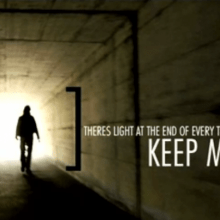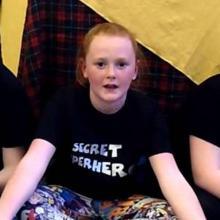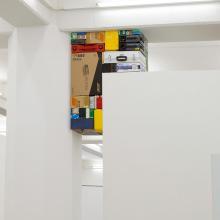Although film and video production has always been at the heart of Plantation Productions work, it has evolved to include participatory arts, such as drama and performance. Acting as a community anchor, the organisation offers an arts and wellbeing programme of activities that promotes social inclusion and improves the confidence and creativity of people in the local community in Govan. The arts and wellbeing programme has its origins in a ‘Time Out’ pilot programme that was devised in partnership with local arts organisations. It continued to grow due to a demand and appetite in the community for more arts based activities. Mental health organisations also wanted to actively encourage those they supported to socially interact with others through arts, but didn’t feel they had the creative skills or resources to do it themselves. Plantation recognised that they could fill the gap as part of their wider community development and regeneration projects.
How is it funded?
The programme is funded by the Community Planning Partnership (Glasgow City Council Integrated Grant Fund), People in Communities Fund (Scottish Government) and the Robertson Trust.
Who runs it? (i.e. arts or social care staff or volunteers?)
The programme involves two full-time and two-part time staff, sessional youth workers and freelance artists. Crucially, individuals that take part in the activities are also involved in the development of the programme. This gives people in the local community a say in the type of activities they would like to pursue, which keeps the programme relevant and interesting to those involved. It is a two-way exchange where the individual has more control of their own support and can be inspired to become more actively engaged in their own community.
How do people hear about it? How are they referred?
The service is open to the local community in Govan and South West Glasgow, but people are also referred from mental health organisations, carers’ networks and addiction agencies. Plantation is invested in the local community, aiming to change perceptions of the area and challenge the stigma that surrounds it. The organisation has become a familiar ‘face’ in the community, people know about it and can pop in or self-refer. Up to 70 people are currently attending the various arts and wellbeing activities.
What type of arts intervention? Who is it for?
Examples of activities include jewellery making, singing, drama, photography and woodwork. Bead ‘n’ Blether was initiated by two local women who were participants on the first Time Out project and were inspired to continue meeting on a weekly basis bringing people together to chat, learn new skills and make attractive jewellery; and Woolly Wednesday is a volunteer-led group that aims to develop skills in knitting and crochet. The Govan Allsorts Community Choir gives those interested in music and song a way to express and enjoy themselves and to engage in their community. The group is often commissioned to sing at events and open days.
Who are the key partners?
The programme has an Arts and Wellbeing Network comprising a mixed group of individuals and representatives from mental health services and other voluntary sector organisations. Partners are key to sustaining the activities of the programme. For example, Glasgow Life provides venues for the activities which would be otherwise difficult to arrange. Partners provide vital resources and expertise in their specialisms, which is invaluable to the development of the arts and wellbeing programme.
What are the outcomes?
Social inclusion
The programme gives individuals, in the words of the managers, a ‘reason to leave the house’ in a lot of cases. The activities encourage an interest in something new and a way to play a more active role in their community.
Confidence and creativity
People feel empowered and are more confident in both their creative and personal ability. The arts activities also help people cope with a challenging time in their lives and to regain confidence and believe in themselves.
Increased sense of achievement
Being creative leads to an increased sense of achievement for individuals. The sessions will often result in the creation of a product, such as a piece of jewellery or photographs, for example.
Health and wellbeing
The improved health and wellbeing of the members is reported. The choir and drama projects in particular have been viewed as a ‘lifeline’ for some people. Where people may only attend sessions for an hour or two in a day, some are now attending a full day and are actively involved in the project. A noted health benefit is that people smoke less over the days they attend sessions.
Peer support
The groups provide a strong peer support network for individuals. People are given the opportunity to chat, share stories, reminisce, which can help coping with bereavement and other challenging life events. Carers get respite from their caring role and can bring something back to the relationship with those they care for.
Feedback from those involved in arts activities:
Before, I didn’t even want to get washed. I used to walk past people - didn’t know how to speak to people. I have new friends - can turn to anyone. At one time I didn’t think I could do anything. I make jewellery, paper mache and knitting. I want to live till I am 100 (Elizabeth)
I have difficulty trusting people. I get strength from the group - I am more in control and making my own decisions. I have benefitted a lot and learned to be with people and re-learn skills I used to have, like knitting patterns which I couldn’t concentrate on before. I am teaching other people. (Jean)
Key messages:
How is quality and effectiveness measured?
General feedback is sought at the end of a block of sessions. Those that referred individuals from organisations are also asked for feedback. Effectiveness is generally measured through this feedback and by attendance and engagement levels.
People often present with depression and anxiety where we can only prescribe medication. If the depression and anxiety was lessened they would require fewer appointments and less money would be spent on anti-depressants. This community based activity is essential. It makes people feel worthwhile, gives a sense of purpose and patients have reported they don’t know what they would do without it.
(Practice Nurse - Govan Health Centre)Following the recent jewellery-making group feedback has been very positive and key workers have requested further arts-based activities in order to meet the needs of our service users, people with severe and enduring mental illness. Having the opportunity to attend an arts-based group like this offers service users a meaningful activity, social contact, contributes to their recovery process and provides a valuable stepping stone to move on to more mainstream community activities.
(Occupational Therapist - Gorbals Mental Health Resource Centre)The taster course in Jewellery Making was the best project we have ever been involved in. Our patients suffer from severe and enduring mental health problems and to say the attendance at the end of the course was as high as at the beginning is exceptional. Key workers reported so many benefits mentioning clients feeling more positive and using the word “life-line”. It is a crucial element that the project is activity based, rather than coffee morning, as pressure to just talk is a barrier for people with complex problems. Talking through activity is more natural and the benefits are far-reaching. A long-term partnership would be key as short term projects stimulate interest, but real benefits for service users are achieved through sustained activity and building social connections. (Occupational Therapist - Stewart Mental Health Resource Centre).
What are the challenges?
- Commitment of partners - over the past year or so membership of the Arts and Wellbeing Network has dwindled due to restructures and lack of funding. This makes it difficult to plan and develop and to maintain relationships when people within agencies change role or move on.
- Time - it is time consuming chasing people up for feedback for evaluation purposes; the resources are not available. Therefore, the outcomes are not always immediately obvious, and take time to emerge.
- Finance - it can be difficult to secure the money to recruit core staff to support programmes that have been funded. It is difficult to plan the programme when funding is based on a yearly basis.
What are the key characteristics of effective practice?
- Doing with rather than to approach – a participant-led agenda which ensures that outcomes are realistic, relevant and personalised
- Support for people to try out new things in a safe environment
- Partnership and collaboration with other organisations - working with people and organisations that have good track records, who are reliable and good at what they do
- Ongoing training, learning and development is important for staff. There are various courses available and it is often their responsibility to signpost to the various places offering support
Recommendations
- Embedded approaches for participatory arts is important and necessary. Sustaining models rather than finishing one project and moving on elsewhere.
- Partnership arrangements are needed for arts programmes to work effectively.
- A deeper understanding of the longer-term impact of participation in the arts is required. Following people through their journey and hearing their story in their own words would be very powerful.
Thanks
Many thanks to Moya Crowley and Angela Ross who gave their time to be interviewed for this case study. IRISS is very grateful to them for their input.



